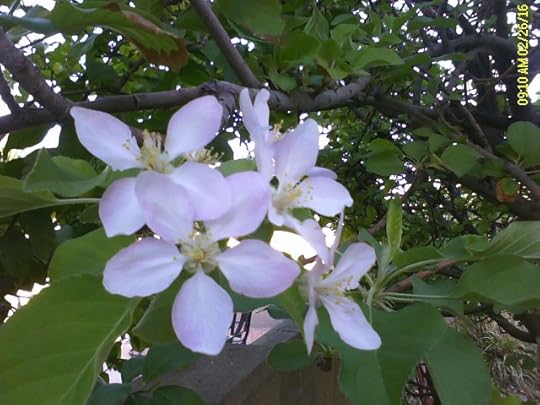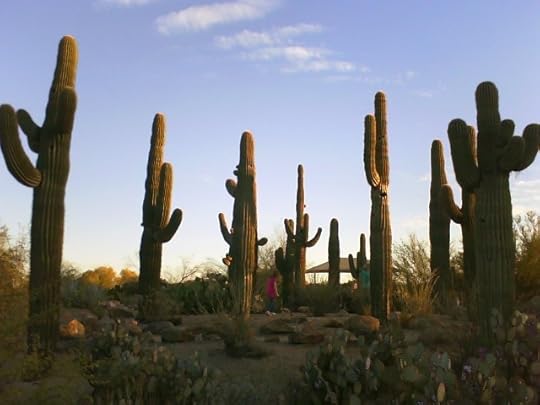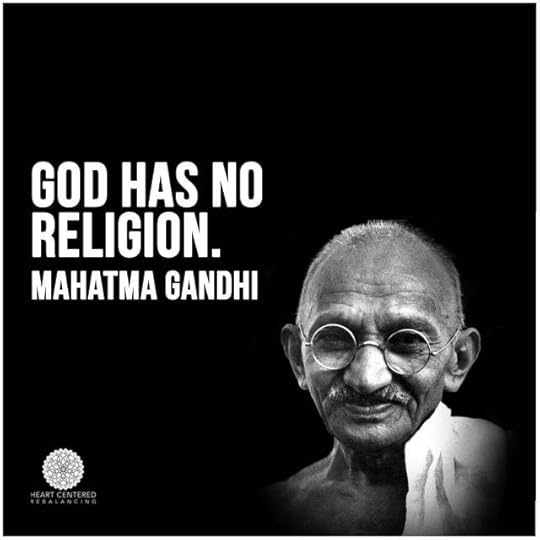Rian Nejar's Blog, page 10
March 12, 2016
A Bicycle in a Car

My good buddy and grad school roommate flew through the major airport here yesterday. He insisted on seeing me, though he had less than a half-hour, near about midnight, at the airport. We are rather close.
So… I loaded my bicycle in my old (200K+ miles) kid transporter, packed some survival food, and left for the rather distant airport. Packed a couple of small gifts for his kids too. My buddy’s reaction, when he saw the bike inside the car, was priceless.
“What is that?”
“To get back home, in case this old clunker dies.”
“Ride all the way?!”
“Hey, two wheels are better than two tired legs…”
He said no more, packed two of the three gifts I’d brought along for his kids into his bag, and got in.
We drove out to a nearby main street and corner shop, sat outside, munching on my survival fare. I dropped him off at midnight, as he’d asked, for he’d seen long lines at security checkpoints in the terminal. He just about made his flight.
~~~~~~~~~~~~~~
March 1, 2016
Review: Cats on the Job: 50 Fabulous Felines Who Purr, Mouse, and Even Sing for Their Supper

Cats on the Job: 50 Fabulous Felines Who Purr, Mouse, and Even Sing for Their Supper by Lisa Rogak
My rating: 4 of 5 stars
A lovely collection of stories of cats in gainful occupations amidst their human companions!
True stories of the crossing-guard cat Sable and the diabetic-alert cat Pippa show more than a little awareness of themselves and others in our feline friends. I’ve come to learn this in experiences with
Lucy
, who adopted my home and me, many years ago. Lucy is of course mistress of the home now.
While the book describes felines assisting humans, there are many instances of cats saving others, their humans, while throwing themselves in harm’s way. Most recently, seen in a video circulated widely, a pet cat saved her child companion from a vicious canine attack. This fearless warrior threw herself at the canine, scratched his face, causing him to let go of the toddler’s leg he had clamped his jaws on. After the dog let go, she made sure to chase him away before following her human who ran back home. Lisa Rogak’s stories add much more to such love cats show us all.
‘Cats on the Job,’ which I received in a Goodreads First Reads Giveaway, is an enjoyable and easy read. Full color pictures provide pleasing visuals within. Recommended to animal lovers everywhere!


February 26, 2016
An Early Spring

Plum branches and blossoms
Spring is decidedly early this year. What with record-breaking temperatures, 15 degrees and more above normal for more than half of February, my trees are rather confused. I’m not complaining. A pleasure to see wintry branches break out in glorious blossoms. Yes, Spring, the season of birds and bees, is here!

Apple flowers
Statisticians say “A single point does not a trend make.” So here. My apple tree is in bloom too. Just some branches, those that survived, in the blight-stricken brave old tree. Only a few blossoms, therefore. Shown above is a close-up with my cell phone camera. New shoots are everywhere, in all other plants in the yard, new life bursting out with the promise of light and warmth.
I think I’ll have a bountiful harvest of plums this year! My neighbor, who makes jam from them, is just as happy…
~~~~~~~~~~~~~~~~
February 18, 2016
Review: Escaping Poverty

Escaping Poverty by Reading Harbor
My rating: 3 of 5 stars
An inspiring collection of life stories by those who’ve known dire financial deprivation first hand.
While a few among the stories in the book approach some comprehension of the multifaceted nature of such life condition, most focus on just not having enough money to meet their needs. Can one not be rich, materially, and yet be poor in a number of other aspects?
An interesting collection, nevertheless, of stories from within the wealthiest of nations. Diligence in editorial corrections can surely enhance quality, and reader appreciation, of contributions within.


February 15, 2016
Review: Spy Secrets That Can Save Your Life: A Former CIA Officer Reveals Safety and Survival Techniques to Keep You and Your Family Protected

Spy Secrets That Can Save Your Life: A Former CIA Officer Reveals Safety and Survival Techniques to Keep You and Your Family Protected by Jason Hanson
My rating: 2 of 5 stars
Interesting and informative, but a loud and distracting sales pitch far more than a helpful book. Innumerable references to the author’s website, and exhortations to view his videos etc., detracted from any true learning from the book.
It is telling, for an ex-spy from the Ceee Ieeye Aaaa, that the author fails to adequately mask details of an incident while casually changing the name of a victim to ‘Danny.’ It does not take much to determine that this particular incident the author uses to support his messages is the car-jacking by the Tsarnaev brothers that eventually led to their kill/capture. But this too may have been an insidious effort by the author, to raise the profile of his work, without due copyright credits given or permissions obtained, to further sensationalize his delivery.
There are numerous editing errors in the book. Overall, a book of low quality, one that is primarily an advertisement for the author’s pecuniary schemes exploiting his government training.


February 2, 2016
Food and Friends
Food has begun to appear on my sidewall. The sweetest of oranges, home-grown.

And I made a new friend over the other side wall. She greets me when I feed my birds everyday. She’s just a year old.

These oranges are a recent development. My next door neighbor, who often gets to enjoy some of my spicy culinary efforts…has an orange tree in her yard. You can just about see it in the background.
‘Bey’ is a new friend. She’s watched me spread seeds on the high back wall, and comes by to say hello often. When I pat her head, she muzzles it, and then places one paw on my hand on the wall. A gesture, not just play, that means so much.
You can see what’s in the yard where Bey plays…but what backyard landscaping do you think is in the yard from which oranges appear? :-)
~~~~~~~~~~~~~~
January 11, 2016
Review: Bunker Hill: A City, a Siege, a Revolution

Bunker Hill: A City, a Siege, a Revolution by Nathaniel Philbrick
My rating: 3 of 5 stars
A highly detailed historical account of events, culminating in a battle between the Continental militia and British regulars on Bunker Hill, just prior to the American declaration of Independence.
The narrative is finely, almost minutely, detailed – to the point of readers discovering how famished, and consequently disgruntled, warring soldiers and generals were at various points in the recounting. While one is transported into the climate, the geography, the events, and the mindsets of people in the times described, this reviewer, despite burning curiosity about his adopted nation’s history, found the author’s descriptions exhausting and above board. Are private lives of key folks really relevant to historical events that loom far above individual lives? Perhaps yes, if a historical narrative focuses upon characters within, but isn’t this work about Bunker Hill, war, and political and social events, and not about individuals’ marriages and their thoughts about personal lives? Nevertheless, the struggle for independence, its varied motivations, events leading up to conflict, and the battles planned and fought are indeed described comprehensively.
The photographic plates inset within were illuminating, though some -landscapes and maps – were hard to appreciate for a lay reader. Their addition to the historical narrative is rather helpful.
Aspects of the work were enlightening revelations to this reviewer. The Boston Tea Party, for instance, commonly supposed by most as a protest against unjust and excessive taxation, having pecuniary motivations on the part of local traders as a principal cause was quite a surprise. Equally astonishing is the fact that these early colonies enjoyed the utmost freedom of all among the colonial empire’s holdings, and yet desired and fought to be entirely independent despite a certain widespread affection maintained for the king of the empire. I begin to see why the continental leaders of that time were compelled to explain the tyranny, that they claimed to have suffered at the hands of said king, in their later declaration of independence from this ruler. I’d always wondered about that laundry list of complaints in such a solemn document.
Of particular interest is an added segment about Phillis Wheatley, an African American poetess of the time, who held publicly that “the insistence upon liberty by the patriots and their [simultaneous] tolerance of African American slavery” was a “strange absurdity.” One cannot but agree with Ms. Wheatley wholeheartedly. The liberty sought by the patriots appears more a severing of ties from the mother country so as to be able to conduct their lives in whatever manner they wished to without interference from those who may constrain their just or unjust actions.
While the writing is clear and effective, minor editing errors (and recto/verso confusion) did occasionally distract from the narrative. A large acknowledgement section (chapter length!) also comes as a surprise. Nevertheless, this is a detailed and informative work that diligent readers, who desire to know more about this specific part of American history, may well enjoy.
_______________________________________


January 7, 2016
As the Market Storm Rages

S&P 500 Index (SPX) on Jan. 7, 2016 (pic: CNBC.com)
In a blog ~10 days ago, we looked at where markets may be headed. The two inferences then were that a downtrend may continue, and that a deeper fall in the markets in 2016 appears likely.
Frankly, I did not expect things to move as rapidly as in the chart above. SPX has fallen from 2061 to 1943 today, a fall of ~5.73%, which is rather significant. The usual suspects (you know, analysts) rattle as reasons softening Chinese manufacturing, the China market plunge cause, Chinese currency manipulation, and jitters about possible lower earnings this quarter, among all other potential causes they can hang their hats on. Some go so far as to say various moves by China to stabilize their markets remind them of moves made here in 1929. Fear mongering, especially the latter.
As this storm rages in markets all over (Asia, Europe, and the United States), it’s fair to ask if this is the beginning of a correction predicted. I think it is just as fair to say this is one among many swings downward – if a correction is indeed to occur this year. There is no rational reason to infer that any deep correction could occur all at once – especially when the FED board convinced itself that the US economy is in good enough shape to begin raising interest rates (which they did last month).
What about market technicals, what do the charts show? I’d hesitate to rely upon technicals at a time when fear is rising (the volatility index, VIX, climbing) and we see deep downward moves on a daily basis. Yet, while the move today did take us out of the lower Bollinger band, volume remains near or only slightly greater than average…there is no panic yet. And, there is support, near ~1900 for the SPX, where a double bottom formed in August and September.
Also, the market has seen five near-consecutive down days, with more than 1% moves on average, bringing it to its current level in a bit more than a week. A very rapid fall. A pull-back up to near 2000, which level will now be resistance, is just as likely as a plunge below 1900 to 52-week lows for the index.
So what’s a lay investor to do? If you’ve borne the fall this far, do nothing. I think that’s what billionaire investor Mark Cuban advised his ‘dusters’ too. If a pull-back up to near 2000 happens in short order, that will be your opportunity to exit positions if you’d like to stay on the sidelines.
Disclaimer/disclosure: I remain long energy, not the general market. Invest with caution always. I am not affiliated with any financial or other institution engaged in investments promotion or transactions.
~~~~~~~~~~~~~~~


January 4, 2016
Empathy, Compassion, and Morality Need No God

A cactus forest in the Southwest evening light
A controversial topic for an essay. Call it Flash Philosophy, if you like. The naughty connotation of ‘flash’ lends some controversy, while this blog post surely qualifies as a brief (therefore, ‘flash’) foray into social philosophy. But seriously, it has become commonplace for people to insist that it is religion that civilized us all, and that God (pick one!) gave us religion. What I’m about to spout will drop not only religion, but one considered its originator as well. Hence the troubling nature of this subject.
But I need help to raise this weighty topic into our consciousness…and who better to assist than that frail old man, a scrappy giant in intellect? See his ears that jut out prominently? A hallmark of one who does not back from a fight. In his life, he won most of them too. Yet, he came to be called, by all those who knew and loved him, ‘Mahatma,’ mahaan-atma, or ‘Great Soul.’

Consider this pithy, meaningful statement by the Mahatma: “GOD has no religion.” Is that not intrinsically true, self evident in a most convincing way? An all-knowing, all-powerful, everywhere-at-once consciousness (do note those wonderful wordy terms avoided: omniscient, omnipotent, omnipresent!) has little need or use for any ‘tribal’ (my self, my family, my clan, my religion, my sort of people, or tribe) affiliation. For such a ‘being,’ assuming one (or more?) in existence, is there any purpose to defining a way of life by means of any religion?
Now why did the Mahatma come up with this – arguably controversial in his time – assertion? I think he spoke not against religion, but for unity. He saw the insidious ‘divide-and-conquer’ methods applied by colonial rulers, and hoped to counter (no, fight!) that with self-evident truths. He spoke to unify all those driven to view each other differently, with suspicion and fear, into one people. I think he succeeded, but history evidences that political forces, that saw his unifying efforts, split his country in two.
Generations later, we still fight. And label each other with terms such as zealots, radicals, fanatics…and attach whichever religion to these descriptors that suits us. We continue to differentiate, discriminate, and sow severe social discord. There is, and perhaps always has been, disunity, disharmony, and consequent destruction of peace. What perpetuates all this?
Throughout recorded history, humans have employed ‘God’ for their purposes. Fear God, for God’s retribution is most severe. God has a special place prepared, for those who sin, to suffer inestimable and unending torment. Serve God, for God will reward servants with all sorts of base pleasures. God instructs us to do these things, for they are our contractual obligations. God demands that we do not question or investigate God. What role does all this play in human society? Is it not self-evident that these are nothing but crude methods of control, where humans employ God for their purposes of maintaining intellectual enslavement of a majority they benefit from?
But there are other manifestations of God too. Some see God as a benevolent and tolerant force that permeates all nature. Makes a lot of sense, doesn’t it, if God is omniscient, omnipotent, and omnipresent? What else, but nature and all life, can one think of that fits such broad definition? When one (often, a culture) shuns personification, models or representations in human persona, one’s view broadens to include all of nature, life, in entirety.
I recall writing this dedication, in my Master’s thesis, two decades ago: “To the benevolence in all that lives, which, in aggregation, I firmly believe, to be God.” I’d moved on then, from God as all nature, to a quality of nature, benevolence.
Nevertheless, life, in its school of hard knocks, teaches us of balance, and of its continuum. Where there is benevolence, there can be as much malevolence too. What we call it really depends – on our perspective, our individual learning, our inclinations.
But what is constant in us all is what we learn, and refine, in ourselves, in those around us, building upon our innate nature. Empathy is innate, and so is compassion, altruism, and growing refinement in our ability to discern right and wrong. I won’t go into all the scientific research that establishes this truth. We reinforce these qualities in ourselves through self-aware application, through our thoughts, actions, and guidance from social consciousness.We manifest culture and civilization.
This is how we grow – from selfish, helpless, babes to selfless and helpful adults. Religion and God may help in early years with guidelines to follow. Yet these are but lampposts along a journey, and are in no way end goals of our life learning. The only discipline needed here, all life long, is continual learning – with the humility that comes from clear awareness of our limitations, our individual scarcity of knowledge and wisdom. I think that is the path to deeper comprehension, enlightenment, and peace within.
So tell me – if you’ve read this far – why do we need God, any God, to empathize, to be compassionate toward all life, and thus to know right from wrong in the continuum of life and nature?
~~~~~~~~~~~~~~
January 3, 2016
Review: Writing Flash Fiction: How to Write Very Short Stories and Get Them Published

Writing Flash Fiction: How to Write Very Short Stories and Get Them Published by Carly Berg
My rating: 5 of 5 stars
An excellent reference for writers of all styles, not just flash fiction. A book to be read once, twice, and as many times as one can to get most of Carly’s insights imprinted in one’s brain.
I discovered ‘flash fiction’ and one-line fiction stories from this informative work by Carly Berg. The very idea of restricting a story to such insane limits horrifies me. A bit old-fashioned, I like to settle into a complex story and enjoy its characters and narration as one may enjoy sights and experiences in a long journey. A writer myself, quickies, in stories, or life, bring up unpleasant psychosomatic reactions. Nevertheless, primed by the soundbite world today, and informed by Carly’s clear and succinct descriptions, I stand educated and enlightened.
Lucid, concise, and creative in descriptions and metaphors (“…danced, snapping his fingers,“”ping-pongy“), this is an enjoyable work about the art and science of writing tight, and writing well. The many aspects of loose writing highlighted will resonate with all writers. Carly reminded me that I write in long sentences that may have my readers gasping for air as they attempt to surface from depths of complexity in my sentence structure. See what I mean? I need to, as she admonishes, “Break them up.” Not with a whole lot of punctuation. Just make them brief and seamless. I enjoyed revisiting all of my own editing efforts as I read through this book.
A minor peeve: for a book about flash fiction, or pieces as short as 500 words, I found this guide a mite long. I haven’t finished it, but have seen enough in it of value to write this review.
Highly recommended to every newbie writer, as a great start to writing short pieces and thus learning to write well before attempting full-length novels, and to every experienced writer, for a refresher on tight writing and habits to eschew or be fully aware of. I need to break this sentence too…old habits die hard!
__________________________________________________













